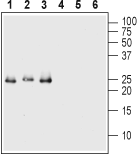Overview
- Peptide (C)DEDQKVRPNEENNKDAD, corresponding to amino acid residues 72-88 of human BDNF (precursor) (Accession P23560). Pro-domain of the BDNF protein.

 Western blot analysis of 50 ng of each Recombinant human Val66Met proBDNF (cleavage resistant) protein (#B-456) (lanes 1 and 4), Recombinant mouse proBDNF protein (#B-240) (lanes 2 and 5) and Recombinant human proBDNF protein (#B-257) (lanes 3 and 6):1-3. Guinea pig Anti-proBDNF Antibody (#ANT-006-GP), (1:200).
Western blot analysis of 50 ng of each Recombinant human Val66Met proBDNF (cleavage resistant) protein (#B-456) (lanes 1 and 4), Recombinant mouse proBDNF protein (#B-240) (lanes 2 and 5) and Recombinant human proBDNF protein (#B-257) (lanes 3 and 6):1-3. Guinea pig Anti-proBDNF Antibody (#ANT-006-GP), (1:200).
4-6. Guinea pig Anti-proBDNF Antibody, preincubated with proBDNF Blocking Peptide (#BLP-NT006).- Following a broad screen of secondary antibodies, the following was used for this application: #106-035-006 (Jackson ImmunoResearch).
 Expression of proBDNF in rat spinal cordImmunohistochemical staining of immersion-fixed, free floating rat spinal cord frozen sections using Guinea pig Anti-proBDNF Antibody (#ANT-006-GP), (1:1000). proBDNF (red) is detected in the superficial layer (arrow) of the dorsal horn of the spinal cord. The myelinated columns are devoid of staining. Cell nuclei are stained with DAPI (blue).
Expression of proBDNF in rat spinal cordImmunohistochemical staining of immersion-fixed, free floating rat spinal cord frozen sections using Guinea pig Anti-proBDNF Antibody (#ANT-006-GP), (1:1000). proBDNF (red) is detected in the superficial layer (arrow) of the dorsal horn of the spinal cord. The myelinated columns are devoid of staining. Cell nuclei are stained with DAPI (blue).
- Lee R. et al. (2001) Science 294, 1945.
- Egan, M.F. et al. (2003) Cell 112, 257.
- Pang, P.T. et al. (2004) Science 306, 487.
- Michalski, B. et al. (2003) Mol. Brain Res. 111, 148.
Brain derived neurotrophic factor (BDNF) is a member of the neurotrophin family of growth factors that includes nerve growth factor (NGF), neurotrophin-3 (NT-3) and neurotrophin-4/5 (NT-4/5).
All neurotrophins are synthesized as preproneurotrophin precursors that are subsequently processed within the intracellular transport pathway to yield proneurotrophins that are further processed to generate the mature form. The mature form of BDNF is a non-covalent stable homodimer that can be secreted in both constitutive and regulated pathways.
Until recently, the functional role of the neurotrophin prodomains were thought to include assistance in the correct folding of the mature protein and the sorting of the neurotrophins into the constitutive or regulated secretory pathway. However, a growing body of evidence suggests that the uncleaved proneurotrophin precursors can be secreted from cells and that they may mediate different biological functions.
The functional importance of the prodomain of BDNF was recently demonstrated in a study showing that a polymorphism that replaces valine for methionine at position 66 of the prodomain, is associated with memory defects and abnormal hippocampal function in humans. Another recent study showed that the regulated extracellular cleavage of proBDNF to mature BDNF by plasmin is necessary for establishing late-phase long-term potentiation (L-LTP), a process that involves long-lasting changes in the structure and function of hippocampal synapses. Finally, proBDNF was shown to be decreased in the brains of patients suffering from Alzheimer’s disease.
Mature BDNF binds to the specific tyrosine kinase receptor TrkB and to p75NTR, a member of the TNF receptor superfamily. proBDNF can similarly bind both receptors although it appears to have a greater affinity for the p75NTR receptor.
Application key:
Species reactivity key:
Alomone Labs is pleased to offer a highly specific antibody directed against the prodomain region of human proBDNF. Guinea pig Anti-proBDNF Antibody (#ANT-006-GP, formerly AGP-032), raised in guinea pig, can be used in western and immunohistochemistry applications. In addition, the antibody is an excellent tool for easy multiplex staining studies. It has been designed to recognize proBDNF from mouse, rat and human samples. The antigen used to immunize guinea pigs is the same as Anti-proBDNF Antibody (#ANT-006) raised in rabbit. Our line of guinea pig antibodies enables more flexibility with our products such as multiplex staining studies, immunoprecipitation, etc.
